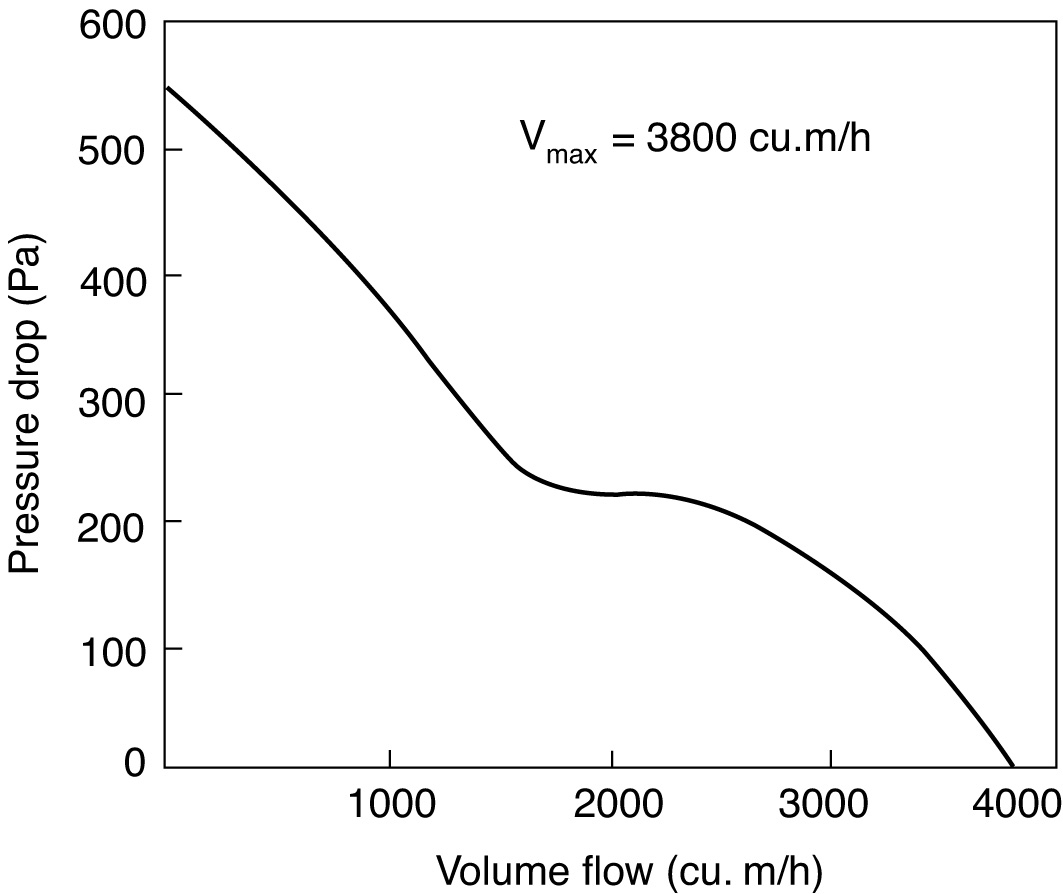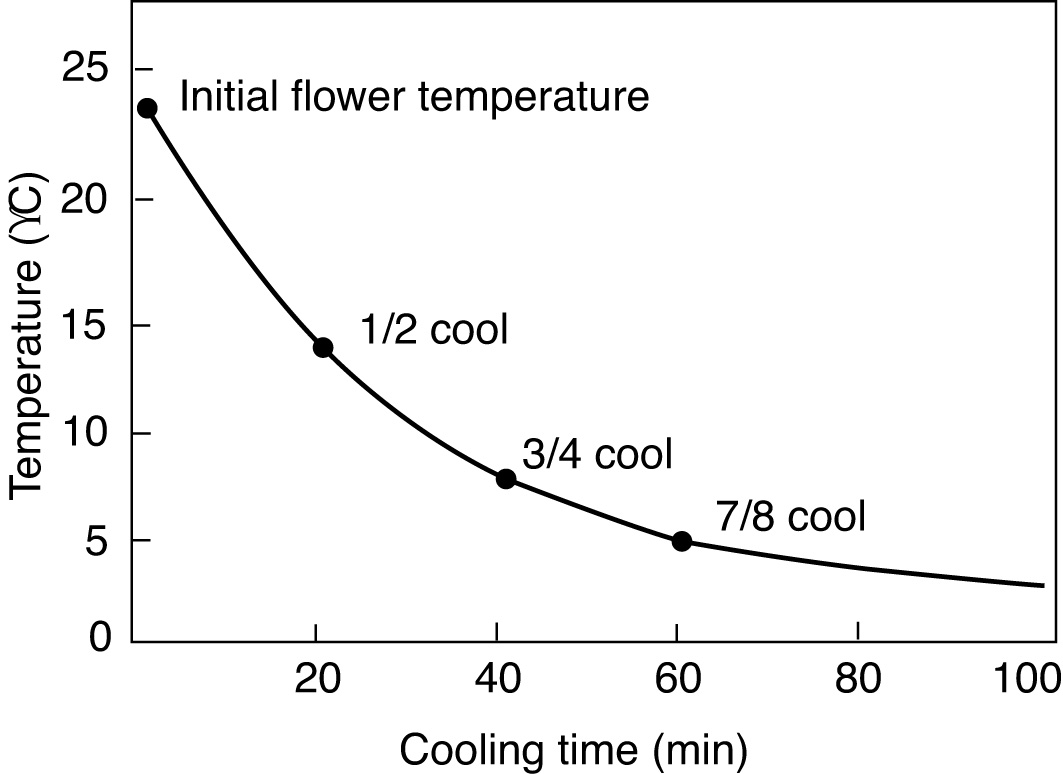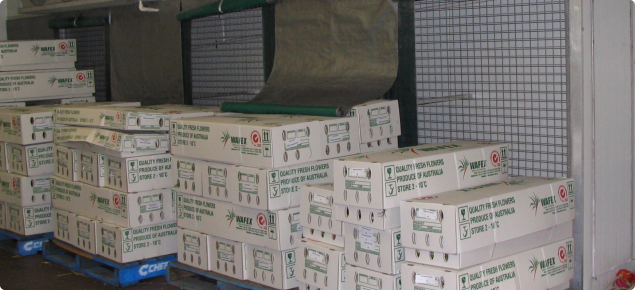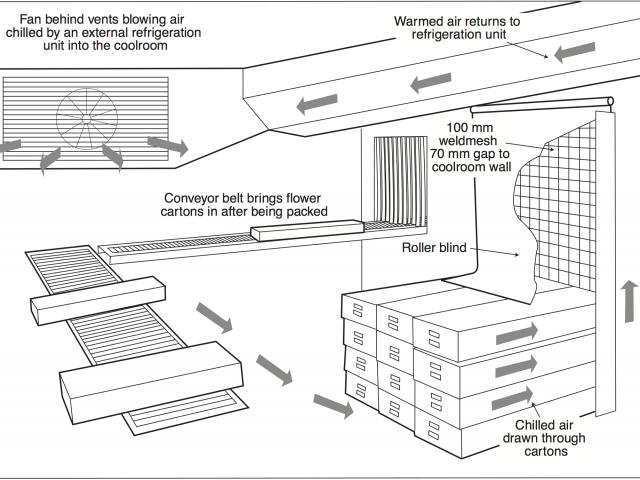Plant material should be cooled as soon as possible after harvest to minimise deterioration. Cooling does this by reducing:
- respiration rates
- water loss
- ethylene production
- sensitivity to ethylene
- microbial development (spoilage).
For example, cooling waxflower from 20°C to 10°C reduces the respiration rate by about 71%. Further cooling from 10°C to 0°C reduces the respiration rate by a further 77%.
Once flowers are cooled they should be kept cool because cycles of warming and cooling may produce condensation leading to Botrytis and other storage diseases.
Cooling methods
Room cooling
The simplest method of cooling cut flowers is to stand them in buckets of preservative solution in a cold room. If circulation of cold air around the blooms is adequate, they cool quickly.
The main disadvantage with this method is that it is not space efficient. If packaged flowers are being stored in the same area, the fluctuations in temperature are not ideal, but generally not a problem unless the storage is long-term (that is, weeks rather than days).
If the flowers are packed in sleeves or cartons while still warm, room cooling is not very effective through poor air circulation. More sophisticated cooling techniques are needed. Room-cooled flowers that re-warm during packaging may also benefit from subsequent cooling within the carton.
Cold walls
This is the best cooling method for everyday use by larger growers/exporters and requires a dedicated coolroom. The pictures below show the components of the system. The coolroom is designed with twin walls or plenums and baffles on both sides, and a gap at the top to allow air circulation.
Boxes of flowers are brought into the coolroom on a conveyor belt and stacked against the wall as shown in Figure 1. Along the top of each cold wall is a row of tarpaulins on rollers. These are attached to the wall just above the air gap. When pulled out over the top of each stack of cartons they help direct the airflow back into the plenum.
The refrigeration compressor that drives the system may be situated some distance from the coolroom itself provided the pipe work is well lagged. In the coolroom itself, cold air is blown out in with a large fan. This causes a vacuum in the ducts above, which helps pull the air through the boxes and up into the wall, where it is then returned to the compressor to start the cycle again.
Temperature probes are placed in the boxes to monitor the cooling process and record the temperature of the air space in the boxes. Once the air inside is thoroughly cool a little extra time is required to ensure that the produce itself is also cooled to the same temperature. The cartons are then transferred to another coolroom where they are stored before shipping.
Vacuum cooling
The most sophisticated way of cooling cut flowers and foliage is vacuum cooling. This method is suited to flowers with a high ratio of surface area to volume. Nevertheless, there is some risk of excessive water loss.
At reduced pressures, water boils at lower temperatures than at normal atmospheric pressure. For instance, at 0.6kPa (about 0.6% of atmospheric pressure) water will boil at 0°C. As water vaporises from plant material it draws heat energy from it. This is what cools the plant material.
To cool 1 kilogram of plant material by 1°C would require the evaporation of about 1.85 grams of water. To cool 1 kilogram of plant material by 20°C (say from 25°C to 5°C) would therefore require evaporation of 20 x 1.85g, that is 37 grams of water. This represents a loss of 3.7% of plant weight.
Such a big loss of water may be unacceptable for some flowers, as it could bring them close to wilting.
Another disadvantage of vacuum cooling is the high cost. Fortunately, there is a cheaper and more flexible alternative: pressure cooling.
Pressure cooling
Pressure, or forced air cooling is the cheapest and most flexible way of cooling packaged flowers fast. The technique involves drawing a stream of cold air through the cartons of flowers. The movement of air through the boxes must be unrestricted.
At least 6% of the area of each face through which air enters or leaves the cartons should be holes or preferably slots (to minimise the risk of blockages). The pathway for airflow in the box should not be obstructed by carton liners, packaging material or flowers packed too tightly.
Ideally, after cooling and before unrefrigerated handling, the ventilation slots should be closed by folding down fibreboard flaps or by applying stickers. A fan is used to draw cold room air through the cartons.
By arranging flower cartons on the cold room floor in two rows with a space of about 60 centimetres between them, then placing a fan at one end of the space and a plastic tarpaulin over the top of the space and resting on the cartons, a simple pressure cooling system is produced (Figure 1).
Flower cartons, being relatively long, are placed only one wide in each of the two rows. Reinforcing battens are sewn into the tarpaulin at about half-metre intervals to prevent the cover from caving in when the fan is running. When the fan is on, it sucks air out of the central space (plenum), drawing cool air through the cartons via the vents at both ends of the cartons.
Axial flow (or propeller type) fans are more economical to run than centrifugal fans. The required volume flow rate of air against the anticipated pressure drop in the central plenum must be estimated. The volume flow rate is defined as the airflow in cubic metres per hour per carton multiplied by the number of cartons to be cooled.
For flowers it is appropriate to base calculations on about 150 cubic metres of air per hour per carton. Thus, for 30 cartons (two rows of 15, Figure 1):
Volume flow rate = 150m3/hr/carton x 30 cartons
= 4500m3/hr
A 25% safety margin should be added:
4500m3/hr x 1.25 = 5625m3/hr
The pressure drop specification, between the outside of the pressure cooling system and inside the central plenum, can be determined by experimentation to give rapid and efficient cooling in combination with a compatible volume flow rate, but about 250 pascals (Pa) is a realistic pressure drop across flower cartons. A safety margin of 25% should also be added:
250Pa x 1.25 = 312.5Pa
Figure 2 shows a typical pressure drop/volume flow relationship for an axial fan with a maximum flow rate of 3800m3/hr. For a pressure drop of 312.5Pa, this fan would draw only about 1300m3/hr.
For our example with 30 cartons, either a fan with greater capacity should be selected or fewer cartons cooled at any one time.

A reliable supplier of quality fans can assist with choice of equipment. A fan speed controller and timer will provide a variable flow system that stops when the pre-set cooling period is over.
Pressure cooling systems will cool flowers in between 10 and 80 minutes, provided that a balanced system is designed and that the refrigeration plant has sufficient capacity to remove the heat. It is generally enough to cool flowers to seven-eighths cool (for example to 2.5°C for flowers initially at 20°C held in a 0°C cold room).
Beyond 7/8ths cool, only small decreases in temperature are obtained for lengthy increases in cooling time (Figure 3). Simple thermocouple thermometers can be used for monitoring flower temperatures during cooling.

The tarpaulin system described is only one of a range of designs to cause cold air to flow through flower cartons. Cold walls, where cartons are placed against slots in a rigidly walled plenum in the cold room, are also used for flowers.
Air-jet conveyor cooling could also be considered. In this system, flowers in unlidded boxes pass on a conveyor under nozzles through which cold room air is directed onto them.
Other methods
Rapid cooling methods involving free moisture, such as hydro-cooling, top-icing and liquid-icing, are not appropriate for cut flowers and foliage.
Enhancing rapid cooling
Where possible, flowers and foliage should be cut in a cool part of the day such as early morning. Late afternoon harvesting may be more desirable for proteas to help minimise leaf blackening.
In hot areas, night picking could be a viable proposition where large areas are to be harvested.
Material cut during the day should be shaded from the sun. Avoid too much delay between picking and cooling.
Packing sheds can be insulated and cooled. Evaporative cooling is useful, particularly when ambient humidities are low. Packing and grading areas may be air-conditioned or even refrigerated to about 15°C.
Acknowledgement
The authors are grateful for the assistance of Total Flower Exports in the preparation of this information - in particular Tony Dick and John Hyland. It also acknowledges Craig Musson of WAFEX for the photograph of a forced air cooling room.


